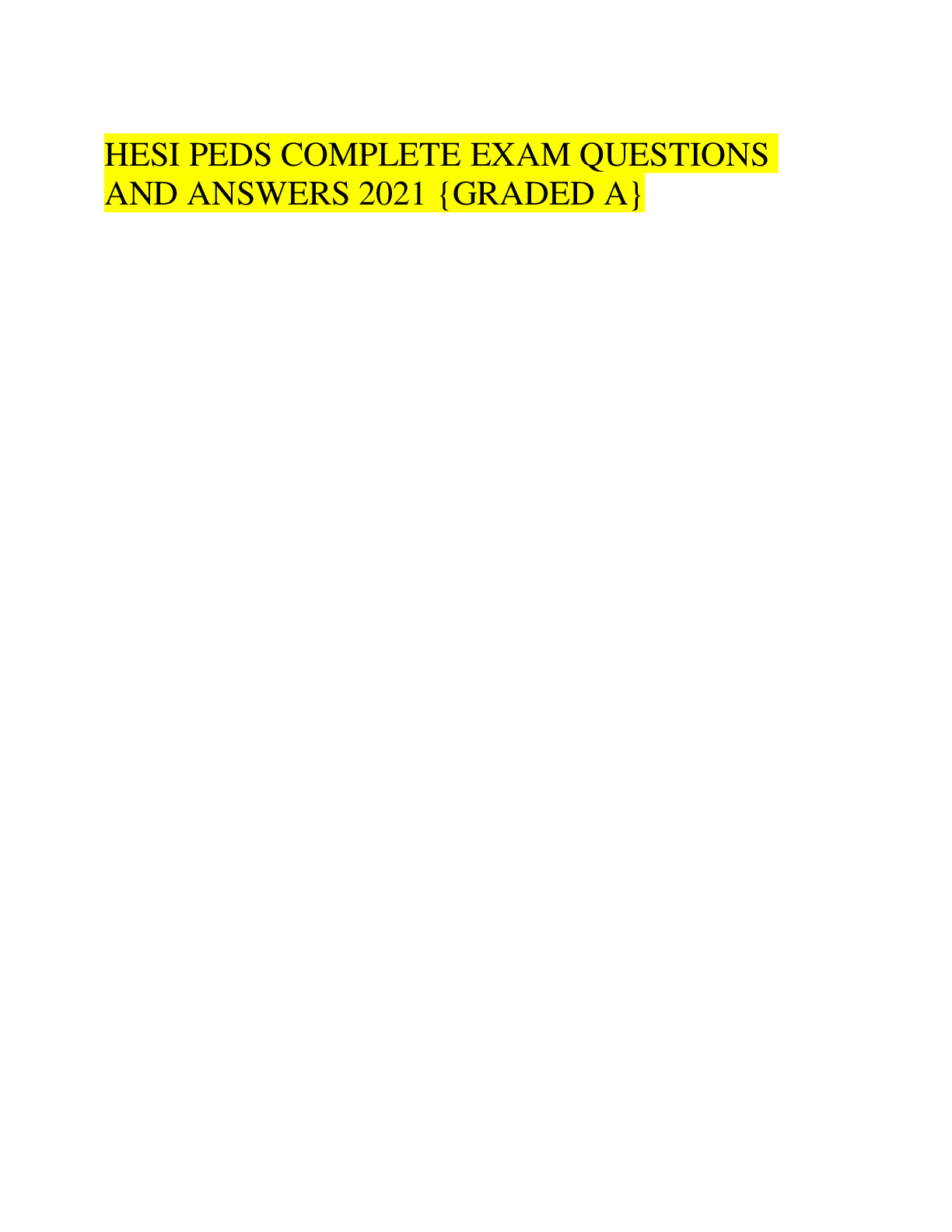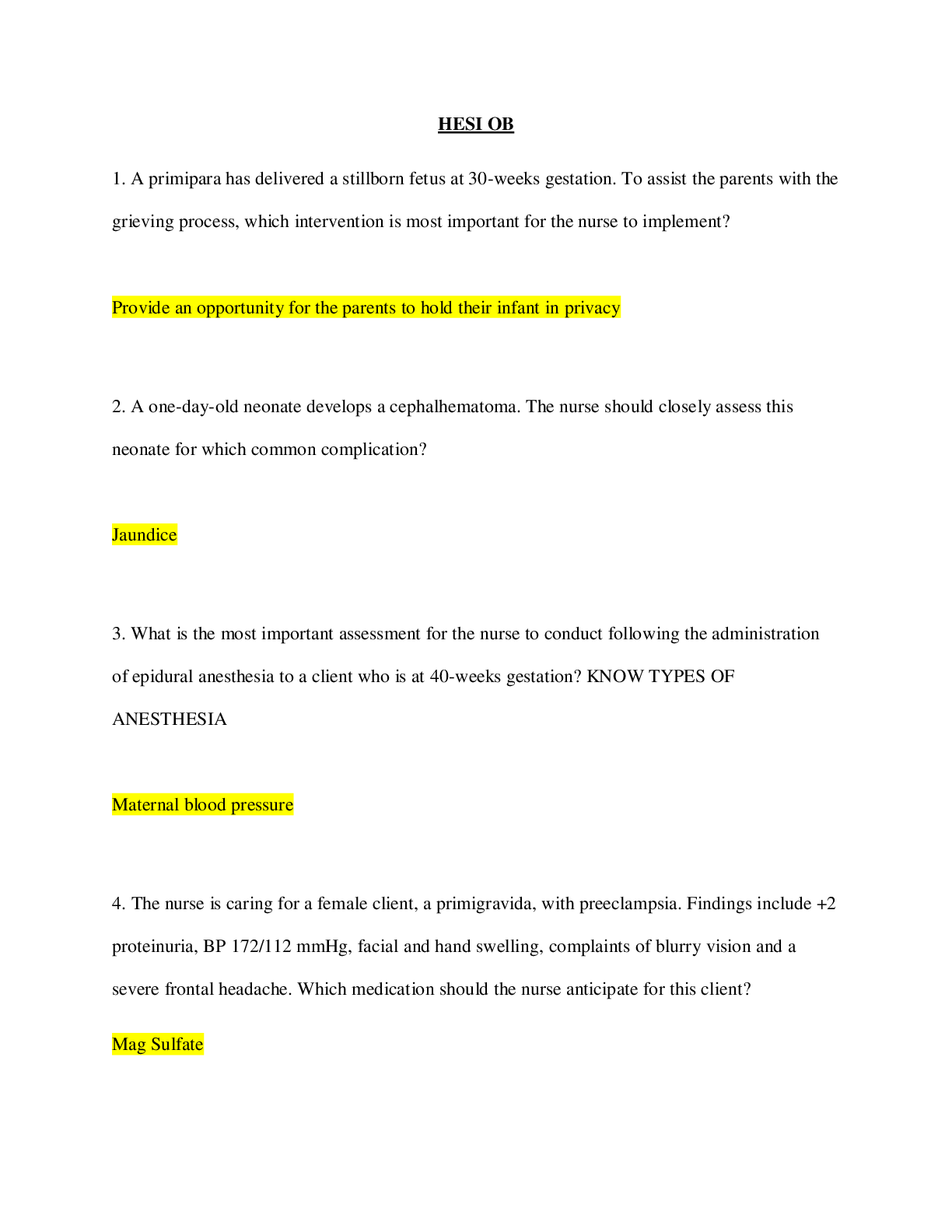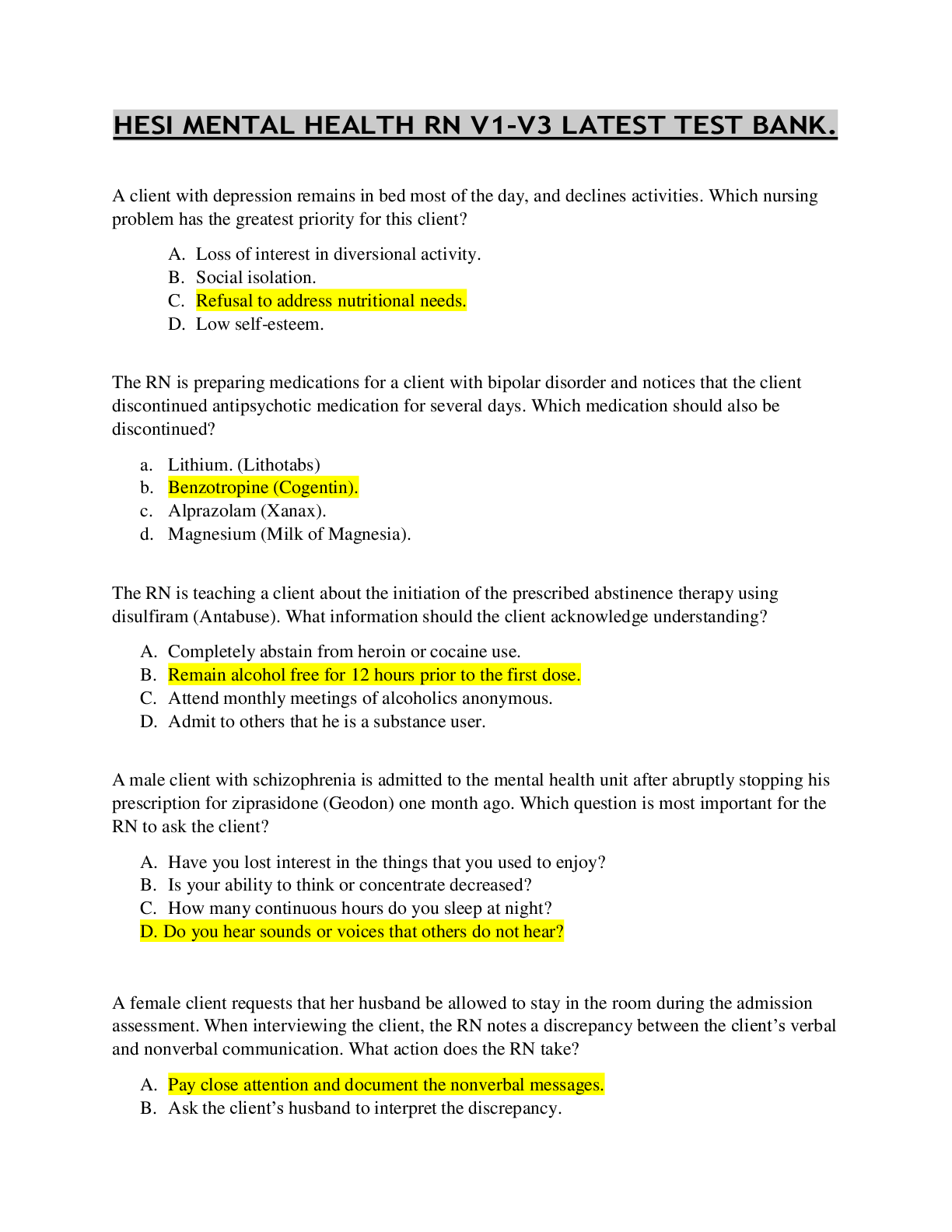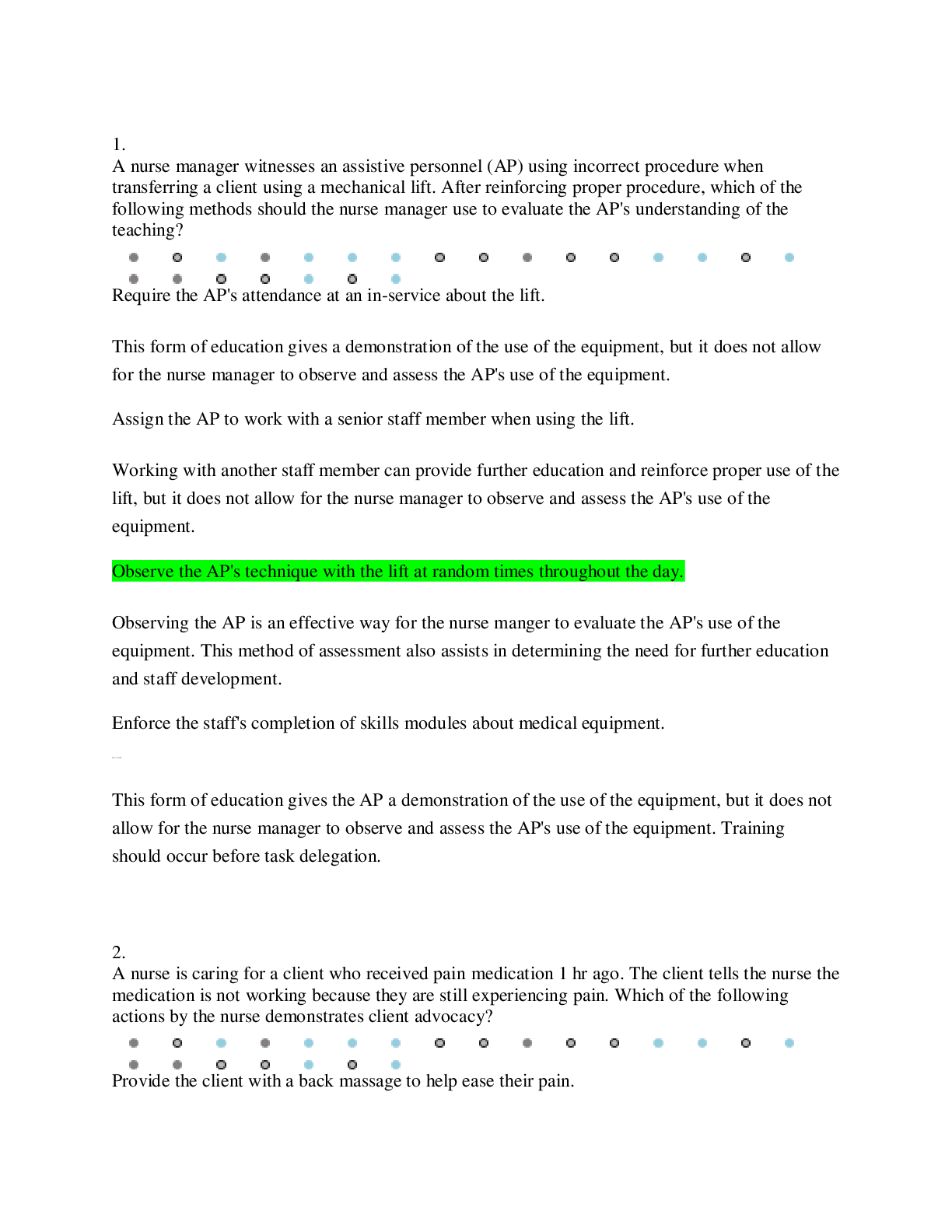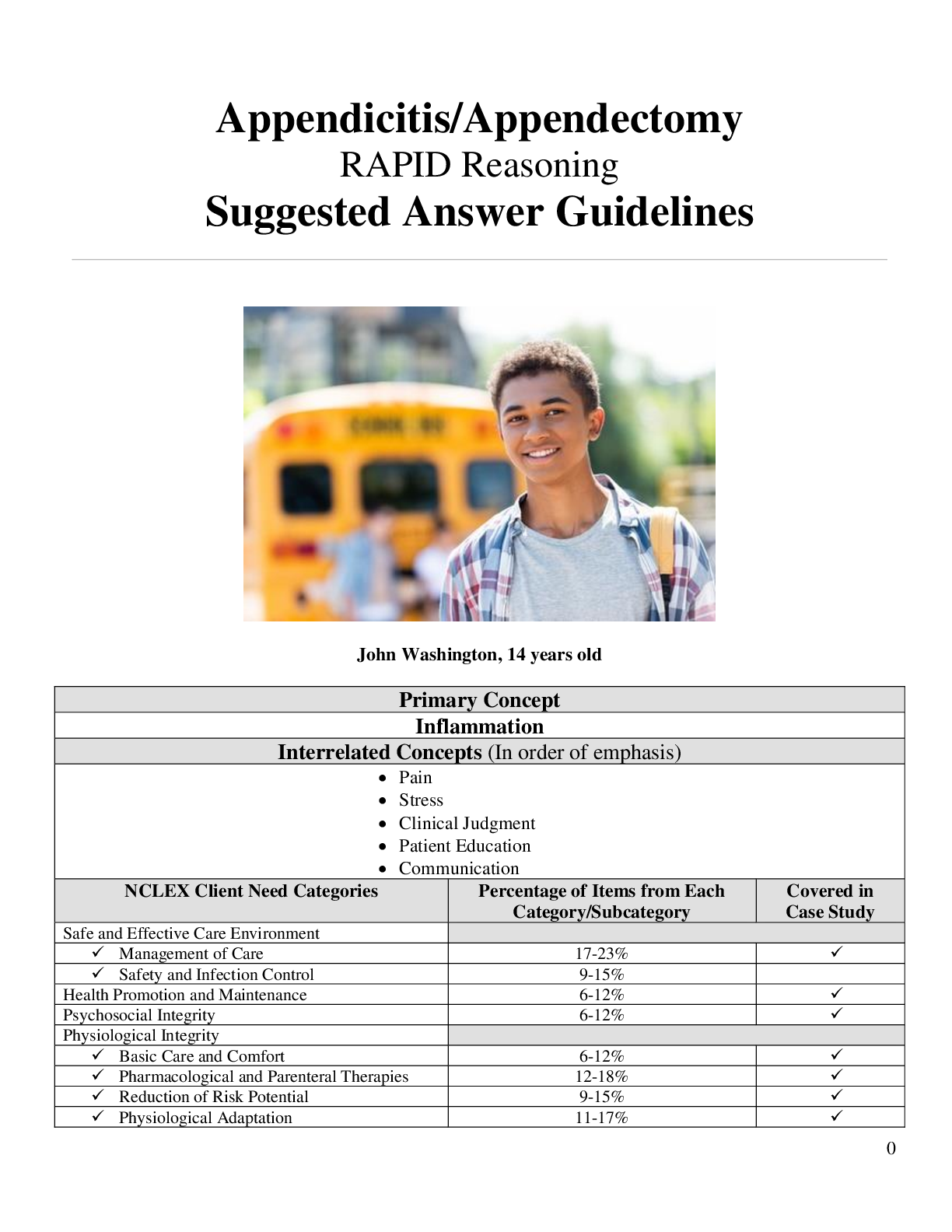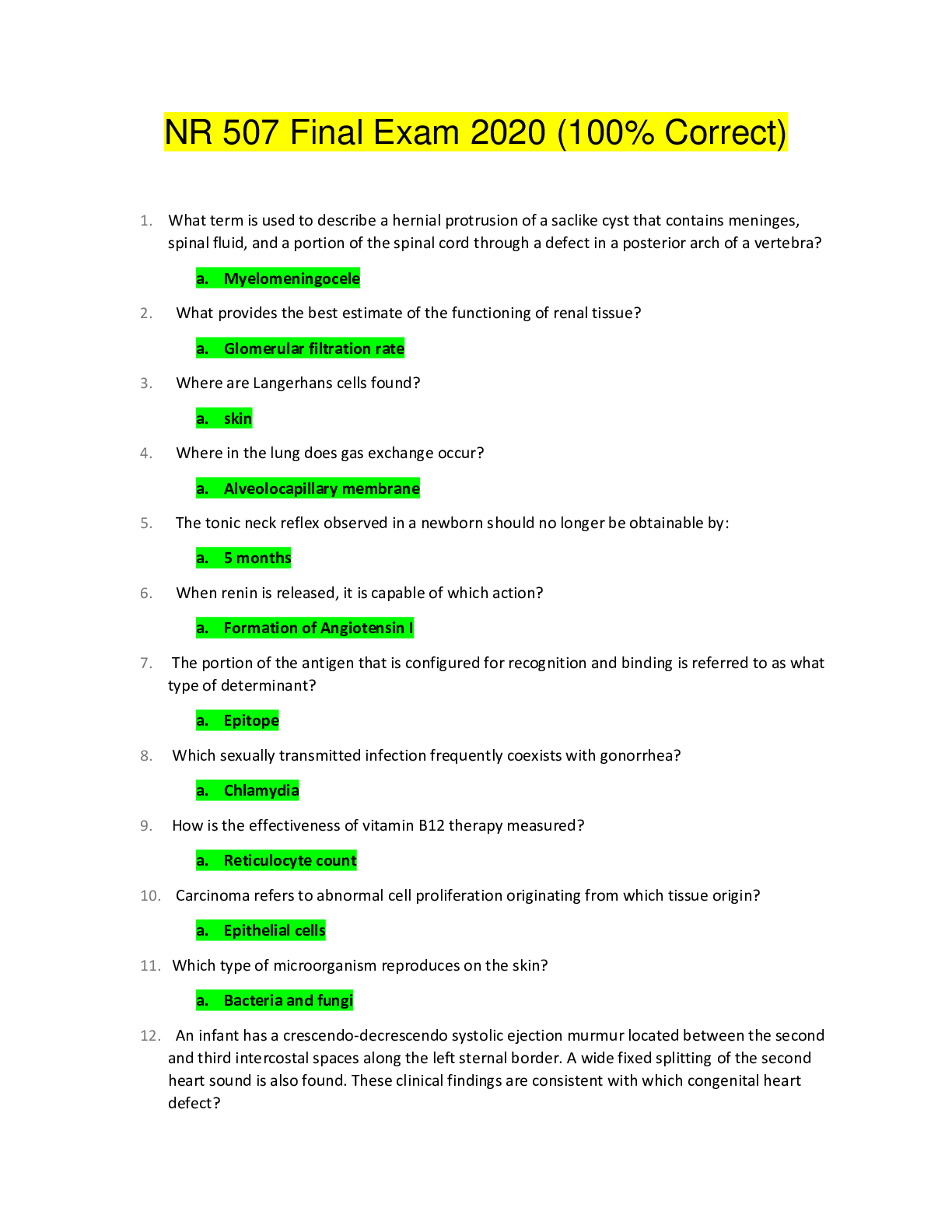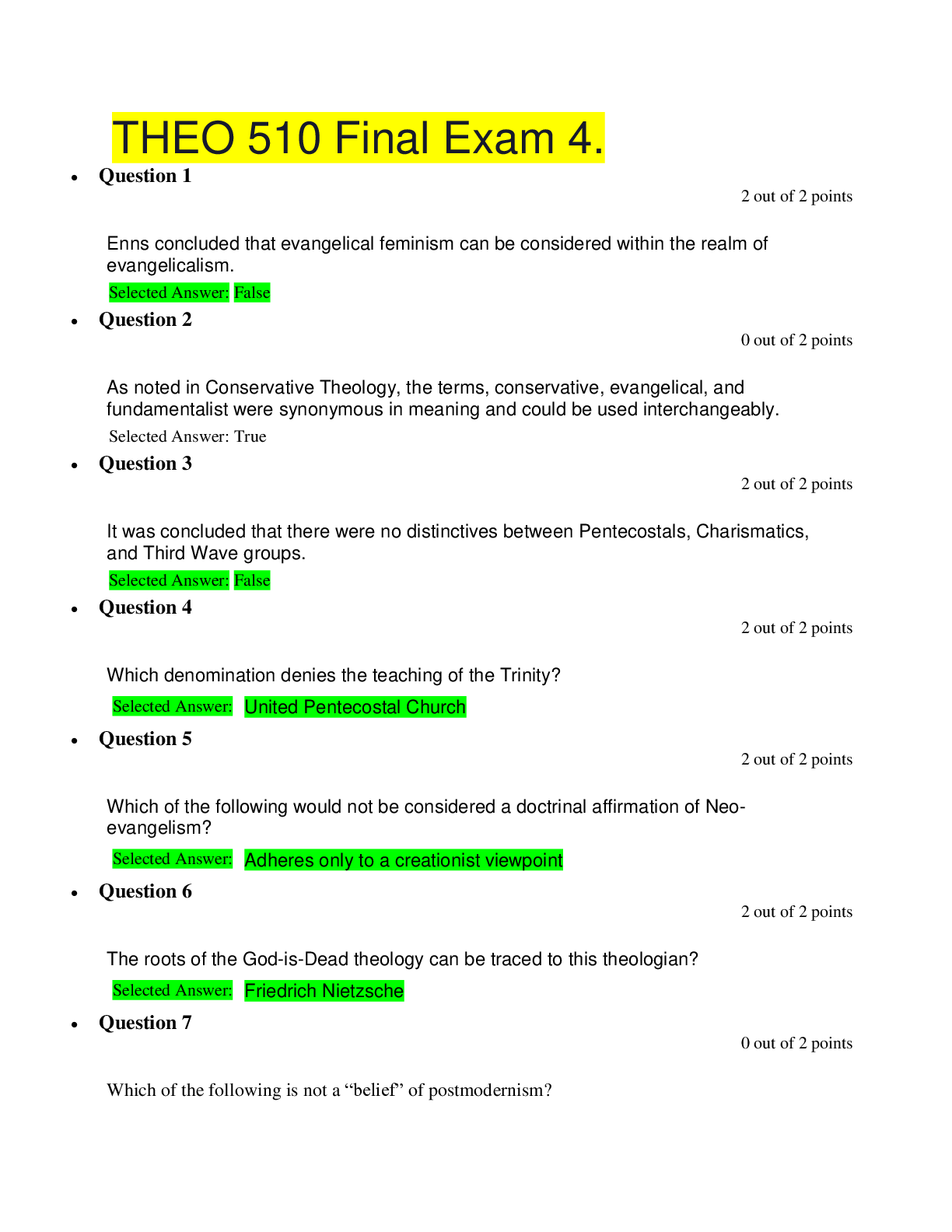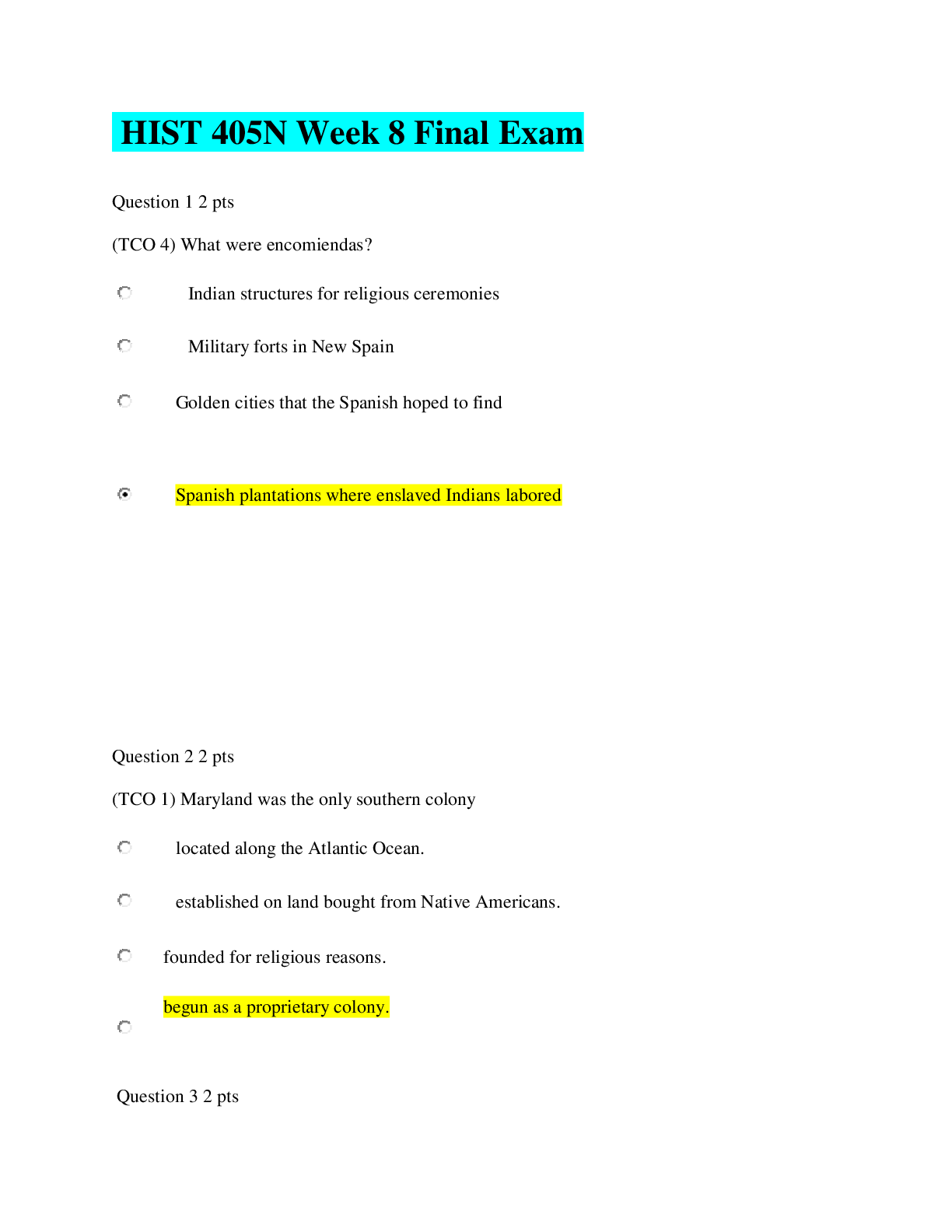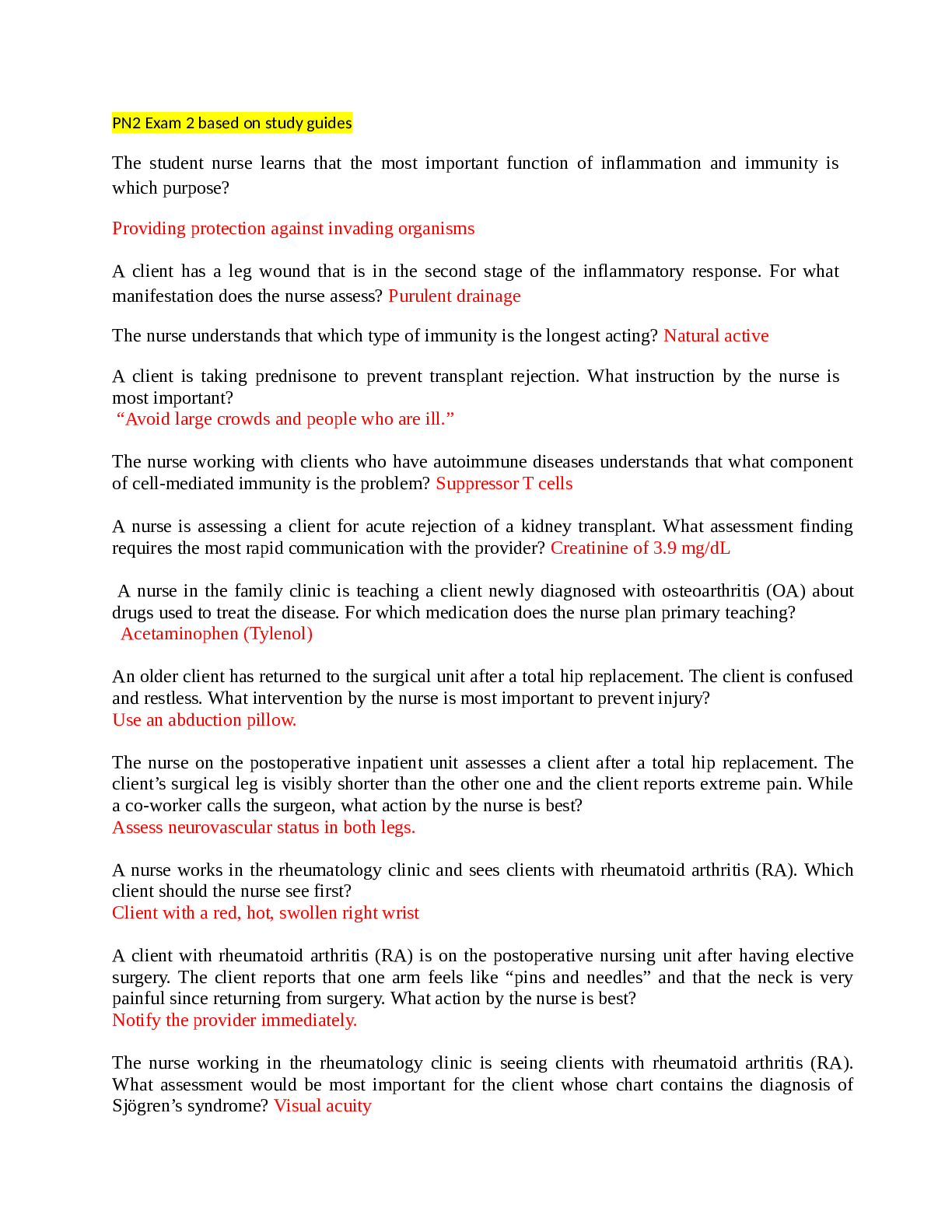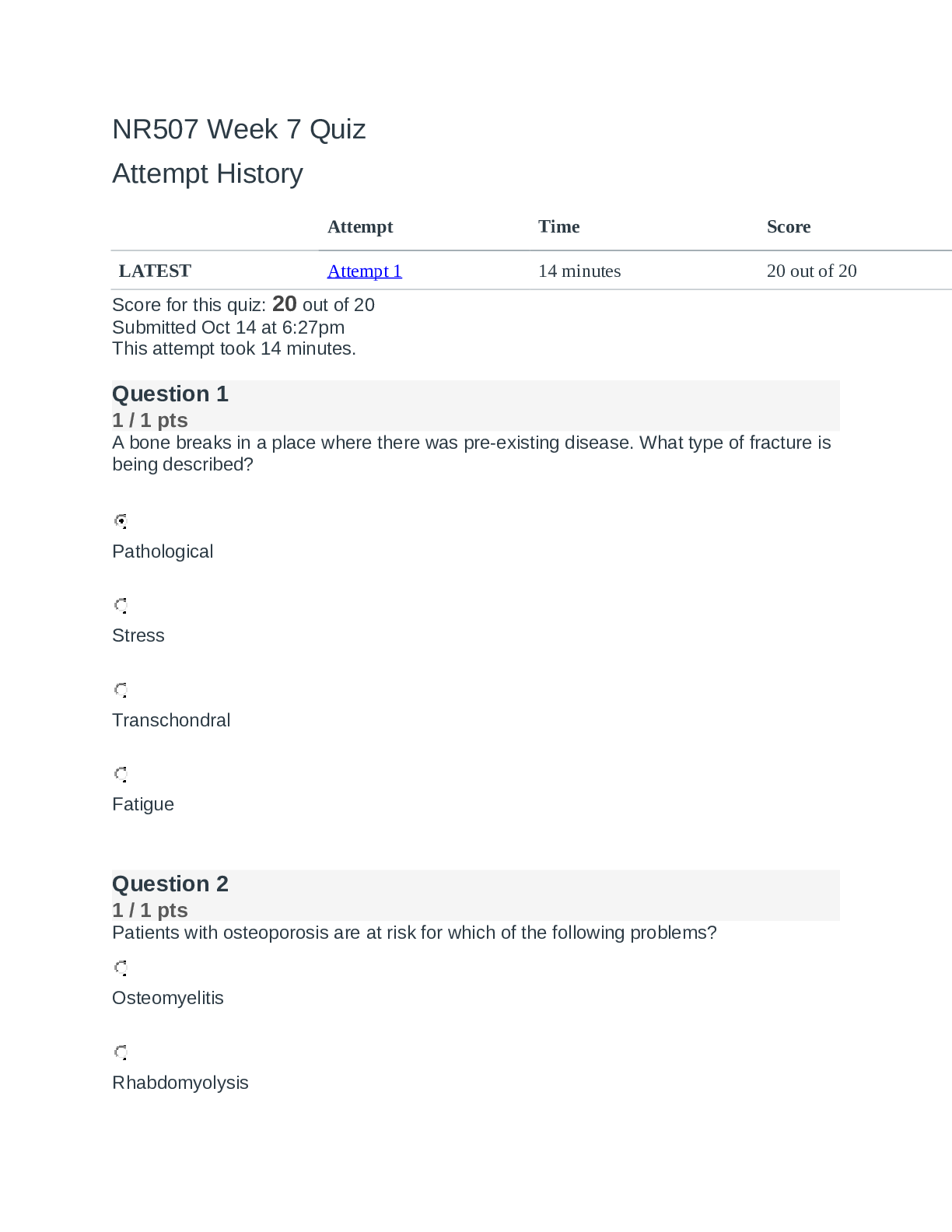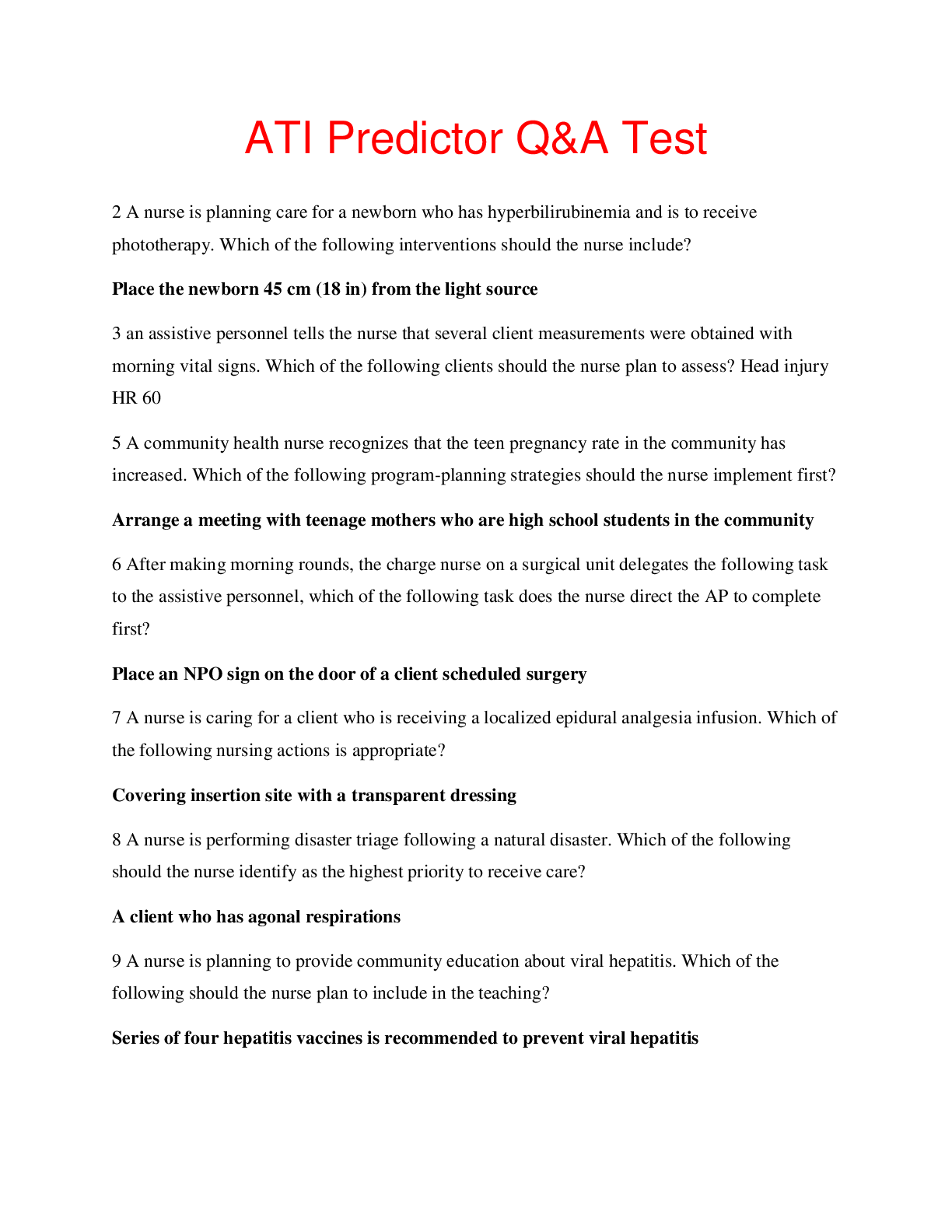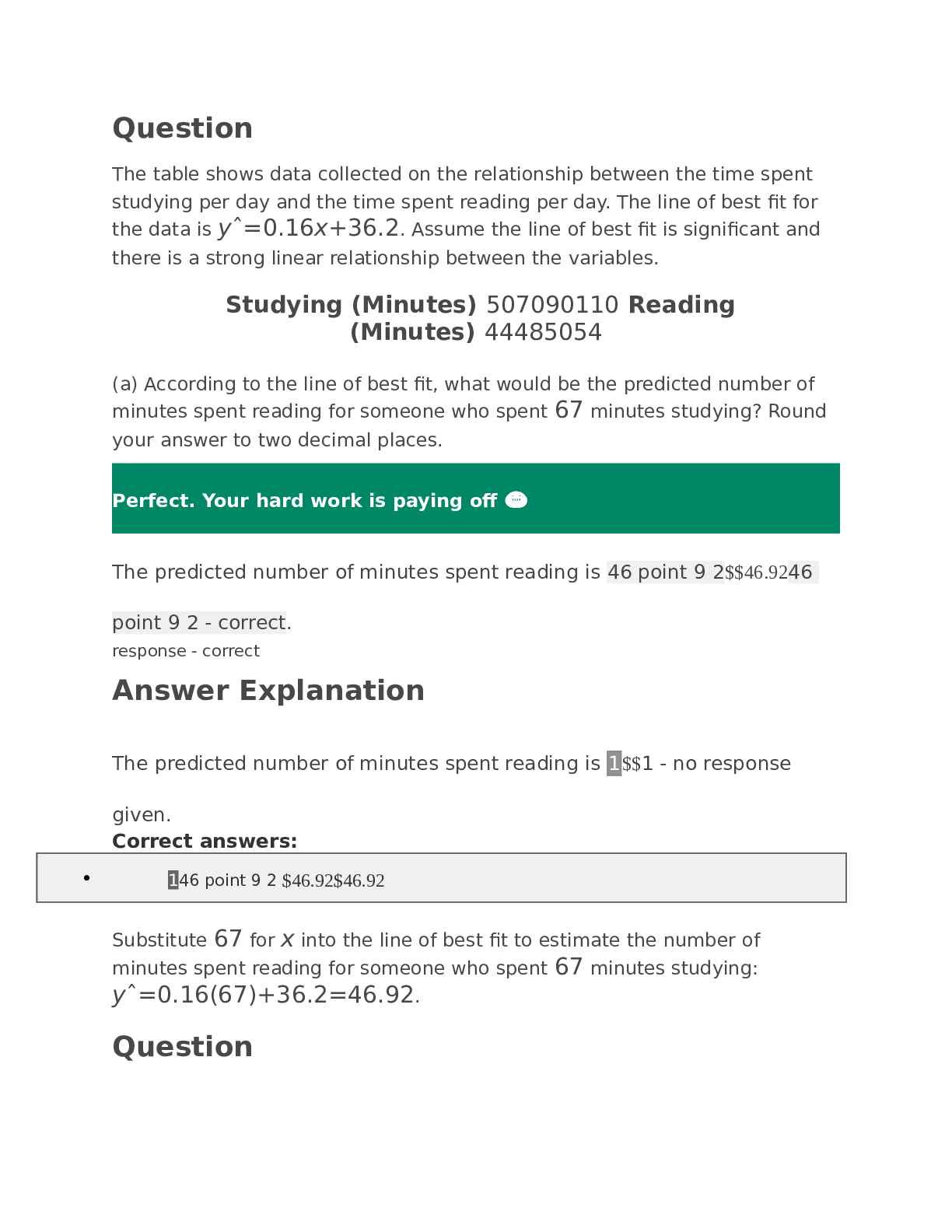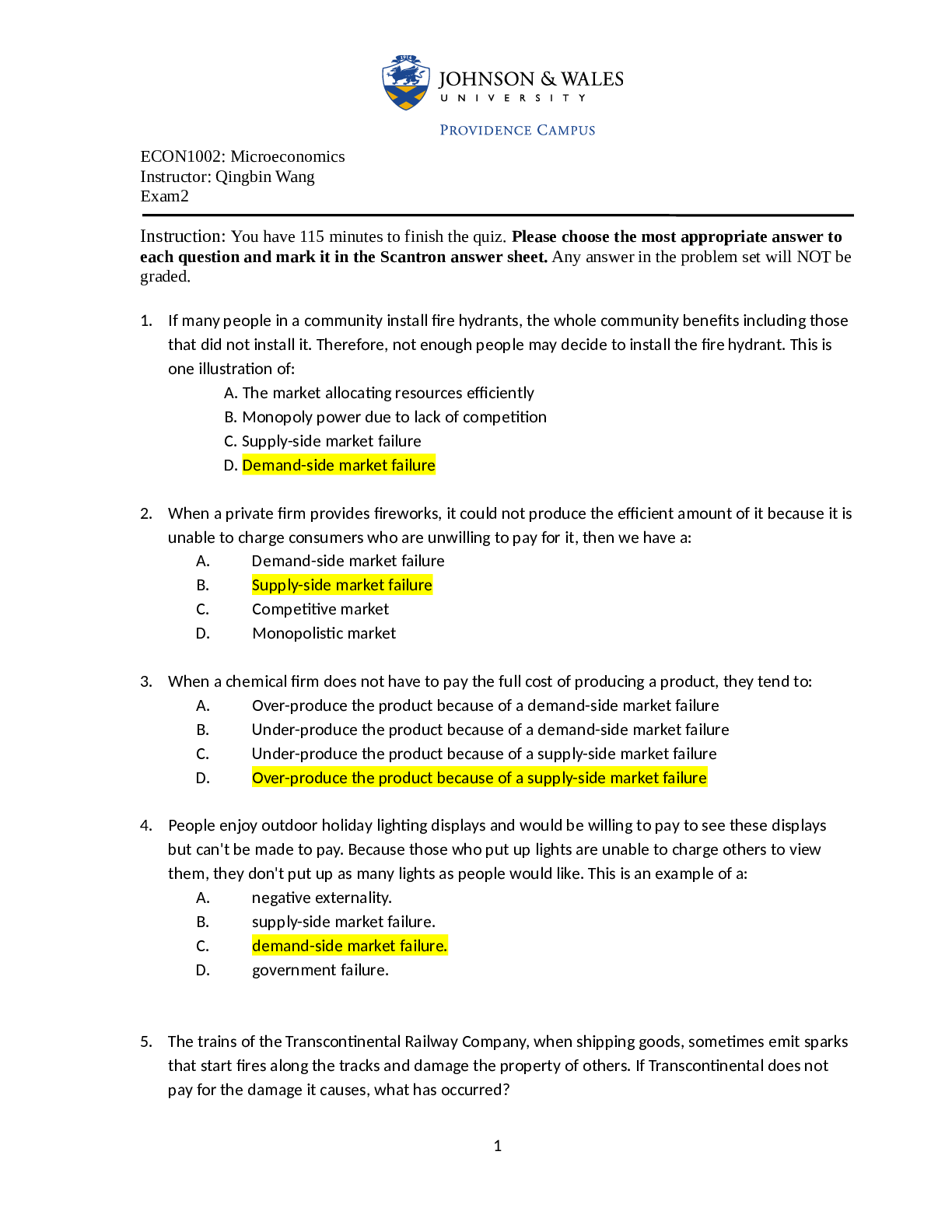ECON 1002: Microeconomics Exam 2_Latest Spring 2020 Complete A+ Solutions
Document Content and Description Below
ECON1002: Microeconomics Exam2 1. If many people in a community install fire hydrants, the whole community benefits including those that did not install it. Therefore, not enough people may decide to ... install the fire hydrant. This is one illustration of: A. The market allocating resources efficiently B. Monopoly power due to lack of competition C. Supply-side market failure D. Demand-side market failure 2. When a private firm provides fireworks, it could not produce the efficient amount of it because it is unable to charge consumers who are unwilling to pay for it, then we have a: A. Demand-side market failure B. Supply-side market failure C. Competitive market D. Monopolistic market 3. When a chemical firm does not have to pay the full cost of producing a product, they tend to: A. Over-produce the product because of a demand-side market failure B. Under-produce the product because of a demand-side market failure C. Under-produce the product because of a supply-side market failure D. Over-produce the product because of a supply-side market failure 4. People enjoy outdoor holiday lighting displays and would be willing to pay to see these displays but can't be made to pay. Because those who put up lights are unable to charge others to view them, they don't put up as many lights as people would like. This is an example of a: A. negative externality. B. supply-side market failure. C. demand-side market failure. D. government failure. 5. The trains of the Transcontinental Railway Company, when shipping goods, sometimes emit sparks that start fires along the tracks and damage the property of others. If Transcontinental does not pay for the damage it causes, what has occurred? A. Positive externality. B. Demand-side market failure. C. Supply-side market failure. D. All of these. 6. Tom buys a piece of shirt for $43 for which he was willing to pay $52. The minimum acceptable price to the seller, Jerry, was $40. Tom experiences: A. a consumer surplus of $12 and Jerry experiences a producer surplus of $3. B. a producer surplus of $9 and Jerry experiences a consumer surplus of $3. C. a consumer surplus of $9 and Jerry experiences a producer surplus of $3. D. a producer surplus of $9 and Jerry experiences a producer surplus of $12. Use the graph to answer questions 7. 7. Refer to the diagram above. If actual production and consumption occur at Q3: A. efficiency is achieved. B. consumer surplus is maximized. C. an efficiency loss (or deadweight loss) of e f occurs. D. an efficiency loss (or deadweight loss) of b d occurs. 8. Which of the following is an example of a public good? A. 911 emergency response system. B. A television set. C. A sofa. D. A laptop. 9. If one person's consumption of a good does not preclude another's consumption, the good is said to be: A. nonrival in consumption. B. rival in consumption. C. nonexcludable. D. excludable. 10. Among the following examples, the one that best illustrates a public good is: A. The laptops used by students in a college or university B. The movies produced by Hollywood companies C. Pine Street next JWU campus D. The airline tickets bought by vacationers 11. Which of the following is an example of a negative externality? A. An increase in the value of land you own when a nearby development is completed B. The costs paid by a company to build an automated factory C. Falling property values in a neighborhood where a disreputable nightclub is operating D. The higher price you pay when you buy a heavily advertised product 12. Nonexcludability describes a condition where: A. one person's consumption of a good does not prevent consumption of the good by others. B. there is no effective way to keep people from using a good once it comes into being. C. sellers can withhold the benefits of a good from those unwilling to pay for it. D. there is no potential for free-riding behavior. 13. Suppose that Mick and Cher are the only two members of society and are willing to pay $20 and $17, respectively, for the third unit of a public good. Also, assume that the marginal cost of the third unit is $35. We can conclude that: A. the third unit should not be produced. B. the third unit should be produced. C. zero units should be produced. D. 4 units should be produced. Use graph to answer question 14 14. Refer to the diagrams in which figures (a) and (b) show demand curves reflecting the prices Alvin and Elmer are willing to pay for a public good, rather than do without it. The collective willingness to pay for the second unit of this public good is: A. $18. B. $14. C. $10. D. $6. 15. It is the custom for paper mills located alongside the Layzee River to discharge waste products into the river. As a result, operators of hydroelectric power-generating plants downstream along the river find that they must clean up the river's water before it flows through their equipment. In the situation described above, we would expect an: A. Overproduction of paper in the mills B. Underproduction of paper in the mills C. External cost resulting from the production of hydroelectric power D. Attainment of allocative efficiency in the market 16. A negative externality or spillover cost occurs when: A. firms fail to achieve allocative efficiency. B. firms fail to achieve productive efficiency. C. the price of the good exceeds the marginal cost of producing it. D. the total cost of producing a good exceeds the costs borne by the producer. 17. Near an ocean beach, a high-rise building is being constructed that will block the scenic view of the ocean by the residents of a low-rise building. The Coase theorem suggests that this type of dispute between the owners of high-rise and low-rise buildings: A. Can be resolved by the owners themselves through individual bargaining B. Has to be resolved by city government officials C. Can only be resolved by a zoning ordinance restricting high-rise buildings D. Should be resolved by a government fine for the builder of the high-rise 18. An emission fee levied against polluting firms will tend to shift the: A. Supply curve of the firms to the left B. Supply curve of the firms to the right C. Demand curve for the product to the left D. Demand curve for the product to the right Use the graph to answer question 19 and 20. 19. Refer to the diagram in which S is the market supply curve and S1 is a supply curve comprising all costs of production, including external costs. Assume that the number of people affected by these external costs is large. Without government interference, this market will reach: A. an optimal allocation of society's resources. B. an underallocation of resources to this product. C. an overallocation of resources to this product. D. a higher price than is consistent with an optimal allocation of resources. 20. Refer to the diagram in which S is the market supply curve and S1 is a supply curve comprising all costs of production, including external costs. Assume that the number of people affected by these external costs is large. If the government wishes to establish an optimal allocation of resources in this market, it should: A. not intervene because the market outcome is optimal. B. subsidize consumers so that the market demand curve shifts leftward. C. subsidize producers so that the market supply curve shifts leftward (upward). D. tax producers so that the market supply curve shifts leftward (upward). Use the graph to answer question 21 and 22. 21. Refer to the diagrams for two separate product markets. Assume that society's optimal level of output in each market is Q0 and that government purposely shifts the market supply curve from S to S1 in diagram (a) on the left and from S to S2 in diagram (b) on the right. The shift of the supply curve from S to S1 in diagram (a) might be caused by a per-unit: A. subsidy paid to the producers of this product. B. tax on the producers of this product. C. subsidy paid to the buyers of this product. D. tax on the buyers of this product. 22. Refer to the diagrams for two separate product markets. Assume that society's optimal level of output in each market is Q0 and that government purposely shifts the market supply curve from S to S1 in diagram (a) on the left and from S to S2 in diagram (b) on the right. The shift of the supply curve from S to S2 in diagram (b) might be caused by a per-unit: A. subsidy paid to the producers of this product. B. tax on the producers of this product. C. subsidy paid to the buyers of this product. D. tax on the buyers of this product. Use graph to answer question 23 23. Refer to the diagram. With MB2 and MC2, society's optimal amount of pollution abatement is: A. Q1. B. Q2. C. Q3. D. Q4. Use the following graph to answer questions 24 to 26 24. Refer to the diagram. The market equilibrium is: A. at price 50 and quantity 10. B. at price 30 and quantity 10. C. at price 10 and quantity 10. D. undetermined. 25. Refer to the diagram. Consumer surplus is: A. $100. B. $200. C. $300. D. $400. 26. Refer to the diagram. Producer surplus is: A. $100. B. $200. C. $300. D. $400. Use the following table to answer questions 27 through 28 27. Refer to the table, if this is for a private goods, like coffee, when the market price is 4, what is the quantity demanded for the whole market: A. 8. B. 9. C. 10. D. 11. 28. Refer to the table, if this is for a public goods, like weather forecast service, what is the collective willingness to pay for the fourth unit of public goods, A. $10. B. $11. C. $12. D. $13. 29. The price elasticity of demand coefficient measures: A. buyer responsiveness to price changes. B. the extent to which a demand curve shifts as incomes change. C. the slope of the demand curve. D. how far business executives can stretch their fixed costs. Use the graph below to answer question 30 30. Refer to the diagram. If price falls from $10 to $2, total revenue: A. rises from A B to A B D C and demand is elastic. B. falls from A D to B C and demand is inelastic. C. rises from C D to B A and demand is elastic. D. falls from A B to B C and demand is inelastic. 31. The demand for a product is inelastic with respect to price if: A. consumers are largely unresponsive to a per unit price change. B. the elasticity coefficient is greater than 1. C. a drop in price is accompanied by a decrease in the quantity demanded. D. a drop in price is accompanied by an increase in the quantity demanded. 32. A perfectly inelastic demand schedule: A. rises upward and to the right but has a constant slope. B. can be represented by a line parallel to the vertical axis. C. cannot be shown on a two-dimensional graph. D. can be represented by a line parallel to the horizontal axis. 33. If the price elasticity of demand for a product is 2.5, then a price increase from $1.80 to $2.00 will: A. increase the quantity demanded by about 2.5 percent. B. decrease the quantity demanded by about 2.5 percent. C. decrease the quantity demanded by about 25 percent. D. increase the quantity demanded by about 250 percent. 34. If the demand for product X is inelastic, a 4 percent decrease in the price of X will: A. decrease the quantity of X demanded by more than 4 percent. B. increase the quantity of X demanded by less than 4 percent. C. increase the quantity of X demanded by more than 4 percent. D. decrease the quantity of X demanded by less than 4 percent. 35. Suppose Aiyanna's Pizzeria currently faces a linear demand curve and is charging a very high price per pizza and doing very little business. Aiyanna now decides to lower pizza prices by 5 percent per week for an indefinite period of time. We can expect that each successive week: A. demand will become more price elastic. B. price elasticity of demand will not change as price is lowered. C. demand will become less price elastic. D. the elasticity of supply will increase. 36. If the demand for pork is relatively elastic, a 10 percent increase in the price of bacon will: A. increase the amount demanded by more than 10 percent. B. decrease the amount demanded by more than 10 percent. C. decrease the amount demanded by less than 10 percent. D. increase the amount demanded by less than 10 percent. 37. The price elasticity of demand for beef is about 0.60. Other things equal, this means that a 20 percent decrease in the price of beef will cause the quantity of beef demanded to: A. decrease by approximately 12 percent. B. increase by approximately 12 percent. C. decrease by approximately 32 percent. D. decrease by approximately 26 percent. 38. If McDonald at Providence is paying its employees minimum wage and its demand for labor is elastic , an increase in the minimum wage will: A. necessarily be inflationary. B. cause the firm's total payroll to increase. C. cause the firm's total payroll to decline. D. cause a shortage of labor. 39. The Illinois Central Railroad once asked the Illinois Commerce Commission for permission to increase its commuter rates by 20 percent. The railroad argued that declining revenues made this rate increase essential. Opponents of the rate increase contended that the railroad's revenues would fall because of the rate hike. It can be concluded that: A. both groups felt that the demand was elastic but for different reasons. B. both groups felt that the demand was inelastic but for different reasons. C. the railroad felt that the demand for passenger service was inelastic and opponents of the rate increase felt it was elastic. D. the railroad felt that the demand for passenger service was elastic and opponents of the rate increase felt it was inelastic. 40. Portside State University raises tuition for the purpose of increasing its revenue so that more faculty can be hired. PSU is assuming that the demand for education at PSU is: A. decreasing. B. relatively elastic. C. perfectly elastic. D. relatively inelastic. 41. If the demand for corn is price inelastic, an introduction of more efficient irrigation system will cause farm revenues to: A. increase. B. decrease. C. be unchanged. D. either increase or decrease, depending on what happens to supply. 42. Suppose that the price of peanuts increases from $2 to $3 per bushel and that, as a result, the total revenue received by peanut farmers changes from $14 to $16 billion. Thus: A. the demand for peanuts is elastic. B. the demand for peanuts is inelastic. C. the demand curve for peanuts has shifted to the right. D. no inference can be made as to the elasticity of demand for peanuts. 43. We would expect: A. the demand for Pepsi to be less price elastic than the demand for soft drinks in general. B. the demand for Pepsi to be more price elastic than the demand for soft drinks in general. C. no relationship between the price elasticity of demand for Pepsi and the price elasticity of demand for soft drinks in general. D. none of these to hold true. 44. Price elasticity of demand is generally: A. greater in the long run than in the short run. B. greater in the short run than in the long run. C. the same in both the short run and the long run. D. greater for "necessities" than it is for "luxuries." 45. The demand for a necessity whose cost is a small portion of one's total income is: A. perfectly price inelastic. B. perfectly price elastic. C. relatively price inelastic. D. relatively price elastic. Use the graph below to answer question 46 46. Refer to the diagram and assume that price increases from $2 to $10. The coefficient of the price elasticity of supply (midpoint formula) relating to this price change is about: A. 5 and supply is elastic. B. 1 and supply is unit elastic. C. 0.25 and supply is inelastic. D. 2.5 and supply is elastic. Use the following table to answer question 47 47. Refer to the table. Over the $6-$4 price range, supply is: A. perfectly elastic. B. elastic. C. perfectly inelastic. D. inelastic. 48. The supply of product X is inelastic (but not perfectly inelastic) if the price of X rises by: A. 5 percent and quantity supplied rises by 7 percent. B. 8 percent and quantity supplied rises by 8 percent. C. 10 percent and quantity supplied remains the same. D. 7 percent and quantity supplied rises by 5 percent. 49. It takes a considerable amount of time to increase the production of pork. This implies that: A. a change in the demand for pork will not affect its price in the short run. B. the short-run supply curve for pork is less elastic than the long-run supply curve for pork. C. an increase in the demand for pork will elicit a larger supply response in the short run than in the long run. D. the long-run supply curve for pork is less elastic than the short-run supply curve for pork. 50. Suppose that the price of product X rises by 20 percent and the quantity supplied of X increases by 15 percent. The coefficient of price elasticity of supply for good X is: A. negative and therefore X is an inferior good. B. positive and therefore X is a normal good. C. less than 1 and therefore supply is inelastic. D. more than 1 and therefore supply is elastic. 51. Assume that in the market for coffee, price increases from $2 to $10, quantity supplied will increase from 5 thousands to 7 thousands cups. The coefficient of the price elasticity of supply (midpoint formula) relating to this price change is about: A. 5 and supply is elastic. B. 1 and supply is unit elastic. C. .25 and supply is inelastic. D. 2.5 and supply is elastic. 52. Supply curves tend to be: A. perfectly elastic in the long run because consumer demand will have sufficient time to adjust fully to changes in supply. B. more elastic in the long run because there is time for firms to enter or leave the industry. C. perfectly inelastic in the long run because the law of scarcity imposes absolute limits on production. D. less elastic in the long run because there is time for firms to enter or leave an industry. 53. The price of old baseball cards rises rapidly with increases in demand because: A. the supply of old baseball cards is price inelastic. B. the supply of old baseball cards in price elastic. C. the demand for old baseball cards is price inelastic. D. the demand for old baseball cards is price elastic. 54. Suppose the cross elasticity of demand for products A and B is 3.6, then A. A and B are complementary products B. A and B are substitutes C. A is normal and B is inferior products D. A and B are not related. 55. Suppose products C and D has a cross elasticity of -5.4, then A. C and D are complementary products B. C and D are substitutes C. C is normal and D is inferior products D C and D are not related. 56. Suppose the income elasticity of demand for toys is 2.00. This means that: A. a 10 percent increase in income will increase the purchase of toys by 20 percent. B. a 10 percent increase in income will increase the purchase of toys by 2 percent. C. a 10 percent increase in income will decrease the purchase of toys by 2 percent. D. toys are an inferior good. 57. If the income elasticity of demand for lard is -3.00, this means that: A. lard is a substitute for butter. B. lard is a normal good. C. lard is an inferior good. D. more lard will be purchased when its price falls. 58. The larger the positive cross elasticity coefficient of demand between products X and Y, the: A. stronger their complementariness. B. greater their substitutability. C. smaller the price elasticity of demand for both products. D. the less sensitive purchases of each are to increases in income. 59. Compared to coffee, we would expect the cross elasticity of demand for: A. tea to be negative, but positive for cream. B. tea to be positive, but negative for cream. C. both tea and cream to be negative. D. both tea and cream to be positive. 60. Suppose that a 10 percent increase in the price of normal good Y causes a 20 percent increase in the quantity demanded of normal good X. The coefficient of cross elasticity of demand is: A. negative and therefore these goods are substitutes. B. negative and therefore these goods are complements. C. positive and therefore these goods are substitutes. D. positive and therefore these goods are complements. [Show More]
Last updated: 1 year ago
Preview 1 out of 15 pages

Buy this document to get the full access instantly
Instant Download Access after purchase
Add to cartInstant download
We Accept:

Reviews( 0 )
$18.00
Document information
Connected school, study & course
About the document
Uploaded On
Apr 10, 2021
Number of pages
15
Written in
Additional information
This document has been written for:
Uploaded
Apr 10, 2021
Downloads
0
Views
71


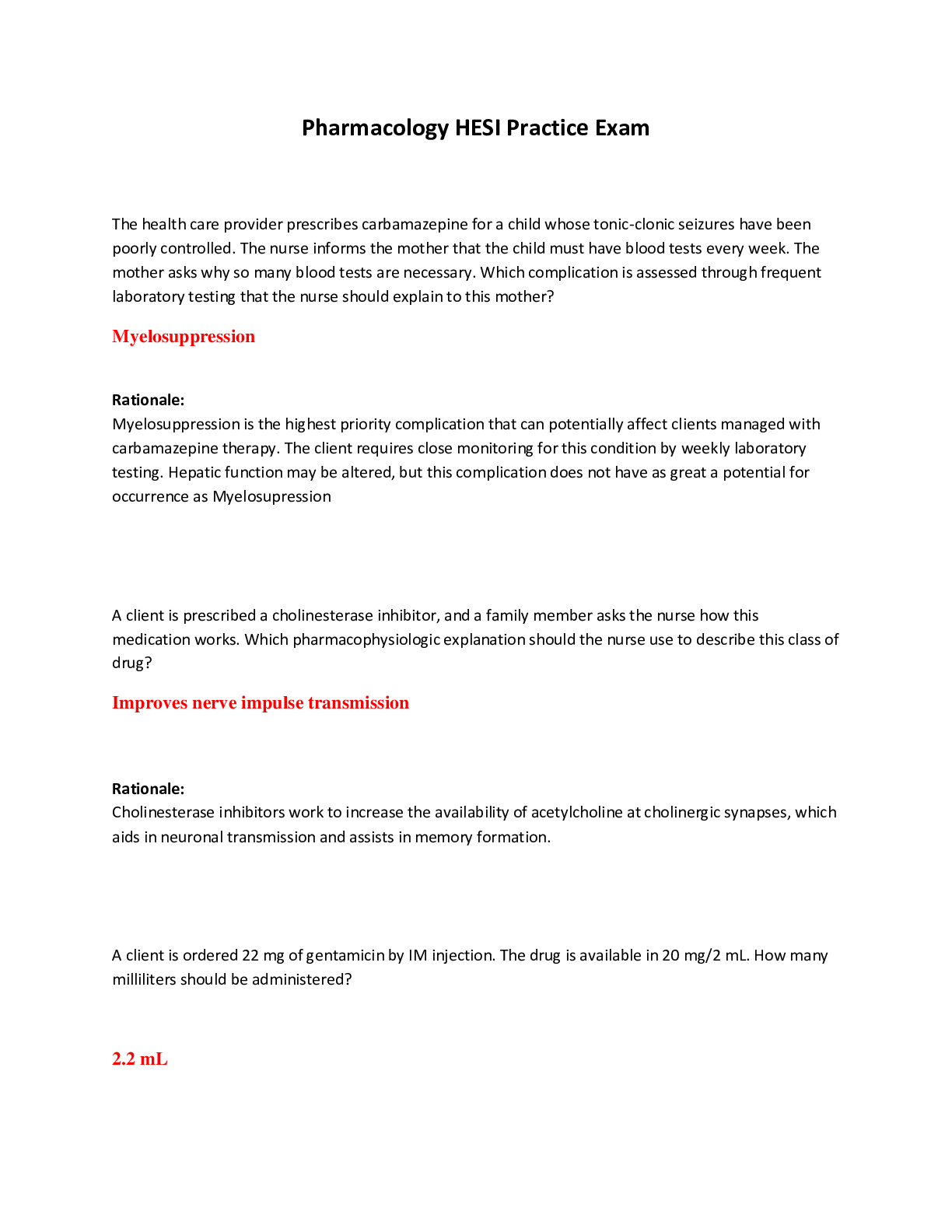
.png)
